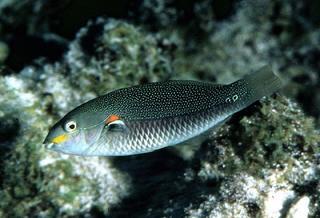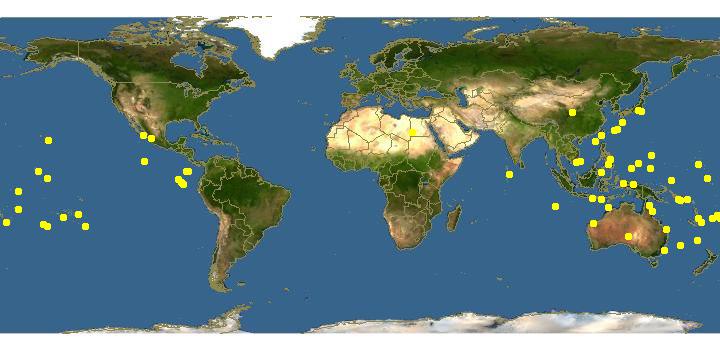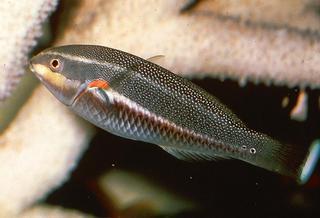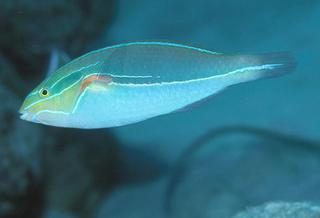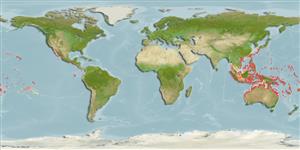|
| Links |
We parsed the following live from the Web into this page. Such content is managed by its original site and not cached on Discover Life. Please send feedback and corrections directly to the source. See original regarding copyrights and terms of use.
- Australian Faunal Directory
- FishBase
|
|
espa˝ol |
|
|
Overview |
Main identification features
- initial phase - brown, yellow cheek, red pectoral axil
- terminal phase blue-grey + 4 blue lines + red pectoral axil
Elongate, fusiform; dorsal rays IX, 11; anal rays III, 11; pectoral rays 14 or 15; lateral line with 25 pored scales; head scaleless; small incisiform teeth in jaws, none noteably enlarged, and a canine present at corner of mouth; lateral line abruptly bent.
Initial phase with numerous small white spots on upper half of side and pair of black spots on caudal fin base; terminal phase green on upper half with bright red patch above pectoral fin base and several thin blue stripes on head and upper half of body.
Size: grows to 15 cm.
Habitat: associated with rocky and coral reefs.
Depth: 0-15 m.
Widespread in the tropical Pacific Ocean from Australia to southern Japan and eastward; scattered eastern Pacific locations - the SW and SE Gulf of California, Costa Rica, western Panama, Isla del Coco, Malpelo, Clipperton and the Galapagos, Gorgona Island in Colombia.
Attributes
Abundance: Common.
Cites: Not listed.
Climate Zone: Northern Subtropical (Cortez Province + Sinaloan Gap); Northern Tropical (Mexican Province to Nicaragua + Revillagigedos); Equatorial (Costa Rica to Ecuador + Galapagos, Clipperton, Cocos, Malpelo).
Depth Range Max: 15 m.
Depth Range Min: 0 m.
Diet: sea-stars/cucumbers/urchins; mobile benthic crustacea (shrimps/crabs); mobile benthic worms; mobile benthic gastropods/bivalves.
Eastern Pacific Range: Northern limit=26; Southern limit=-2; Western limit=-115; Eastern limit=-79; Latitudinal range=28; Longitudinal range=36.
Egg Type: Pelagic; Pelagic larva.
Feeding Group: Carnivore.
FishBase Habitat: Reef Associated.
Global Endemism: All Pacific (West + Central + East); Indo-Pacific only (Indian + Pacific Oceans); TEP non-endemic; "Transpacific" (East + Central &/or West Pacific); All species.
Habitat: Corals; Reef associated (reef + edges-water column & soft bottom); Rocks; Reef (rock &/or coral); Reef only.
Inshore Offshore: Inshore; Inshore Only.
IUCN Red List: Not evaluated / Listed.
Length Max: 15 cm.
Regional Endemism: Island (s); Continent; Continent + Island (s); Tropical Eastern Pacific (TEP) non-endemic; Eastern Pacific non-endemic; All species.
Residency: Resident.
Salinity: Marine; Marine Only.
Water Column Position: Bottom; Bottom only;
|
|
|
Names | |
|
|
|
Links to other sites | |
|
|
|
References |
- Allen , G.R. and Robertson, D.R., 1994., Fishes of the Tropical Eastern Pacific., Crawford House Press Pty Ltd:1-332.
- Allen , G.R. and Robertson, D.R., 1997., An Annotated Checklist of the fishes of Clipperton Atoll, Tropical Eastern Pacific., Revista de Biologia Tropical, 45:813-843.
- Baldwin , C. C. and McCosker, J. E., 2001., Wrasses of the Galßpagos Islands, with the description of a new deepwater species of Halichoeres (Perciformes: Labridae)., Revista de Biologia Tropical, 49(Supplement 1):89-100.
- Bleeker,., 1851., Bijdrage tot de kennis der ichthyologische fauna van de Banda-eilanden., Natuurkd. Tijdschr. Neder. IndiŰ, 2:225-261.
- Bussing, W.A., 1987., Los peces de la familia Labridae de la Costa PacÝfica de Costa Rica., Revista de Biologia Tropical, 33:81-98.
- Castro-Aguirre, J.L. and Balart, E.F., 2002., La ictiofauna de las islas Revillagigedos y sus relaciones zoogeograficas, con comentarios acerca de su origen y evolucion. En: Lozano-Vilano, M. L. (Ed.). Libro Jubilar en Honor al Dr. Salvador Contreras Balderas., Universidad Autonoma de Nuevo Leˇn:153-170.
- Fischer , W. , Krup , F. , Schneider , W. , Sommer , C. , Carpenter , K. E. and Niem, V. H., 1995., Guia FAO para la Identificacion de Especies de para los fines de la Pesca. Pacifico Centro-Oriental. Volumen III. Vertebrados - Parte 2., FAO3:1201-1813.
- Lopez , M. I. and Bussing, W. A., 1982., Lista provisional de los peces marinos de la Costa Rica., Revista de Biologia Tropical, 30(1):5-26.
- Robertson , D.R. and Allen, G.A., 1996., Zoogeography of the shorefish fauna of Clipperton Atoll., Coral Reefs, 15:121-131.
- Victor , B. C. , Wellington , G. M. , Robertson , D. R. and Ruttenberg, B., 2001., The effect of the EL Ni˝o-Southern oscilation event in the distribution of reef-associated labrid fishes in the Eastern Pacific ocean., Bull. Mar. Sci., 69:279-288.
- Victor, B. C. and Wellington, G. M., 2000., Endemism and the pelagic larval duration of reef fishes in the eastern Pacific Ocean., Marine Ecology Progress Series, 205:241-248.
- Victor, B. C., 1986., Durtation of the planktonic larval stage of one hundred species of Pacific and Atlantic wrasses (family Labridae)., Marine Biology, 90:317-326.
|
|
|
Acknowledgements | |
I thank Ashley MacDonald and John Pickering, University of Georgia, for technical support in building this page.
|
|
| Supported by | |
|
Following modified from Australian Faunal Directory
|
Top | See original
| &pull 20q v5.145 20180528: Error 301 Moved Permanently http://biodiversity.org.au/afd/taxa/1e2ae20f-51a2-4468-92ec-51e1b8a37883 |
|
Following modified from FishBase
|
Top | See original
http://www.fishbase.org/Summary/speciesSummary.php?genusname=Stethojulis&speciesname=bandanensis ---> http://192.134.151.83/Summary/speciesSummary.php?genusname=Stethojulis&speciesname=bandanensis
http://192.134.151.83/Summary/speciesSummary.php?genusname=Stethojulis&speciesname=bandanensis ---> https://fishbase.mnhn.fr/Summary/speciesSummary.php?genusname=Stethojulis&speciesname=bandanensis
https://fishbase.mnhn.fr/Summary/speciesSummary.php?genusname=Stethojulis&speciesname=bandanensis ---> https://fishbase.mnhn.fr/summary/Stethojulis-bandanensis.html
Stethojulis bandanensis, Red shoulder wrasse : fisheries, aquarium

You can
sponsor
this page
Common name (e.g. trout)
Genus + Species (e.g. Gadus morhua)
-

-
About this page
-
Languages
-
User feedbacks
-
Citation
-
Uploads
-
Related species
-


 Red shoulder wrasse
Add your observation in
Fish Watcher
Upload your
photos
and
videos
Red shoulder wrasse
Add your observation in
Fish Watcher
Upload your
photos
and
videos
Pictures
|
Videos |
Stamps, Coins Misc.
|
Google image
 Stethojulis bandanensis
Stethojulis bandanensis
Picture by
Randall, J.E.
Teleostei (teleosts) >
Eupercaria/misc
(Various families in series Eupercaria) >
Labridae
(Wrasses) > Corinae
Etymology:
Stethojulis:
Greek, stetho, stethion = brest; literal = to prick a little breast + Greek, ioulis, a fish dealing with genera Coris or Thalassoma (Ref.
45335
)
.
More on author:
Bleeker
.
Environment: milieu / climate zone / depth range / distribution range
Ecology
Marine; reef-associated; depth range 0 - 30 m (Ref.
9311
). Tropical; 32°N - 32°S, 92°E - 89°W
Indo-Pacific: eastern Indian Ocean to western Australia, including the Christmas Island, Cocos-Keeling and the Andaman Sea; then from Japan to New South Wales, Australia. Eastern Pacific: offshore islands in the eastern Pacific, including Clipperton, Cocos and the Galapagos islands (Ref.
36378
). Range extends to Baja California during El Ni├▒o (Victor, pers. comm.). Replaced by
Stethojulis albovittata
in the western Indian Ocean and
Stethojulis balteata
in the Hawaiian Islands (Ref.
37816
).
Size / Weight / Age
Maturity: L
m
?
range ? - ? cm
Max length : 15.0 cm TL male/unsexed; (Ref.
30874
); 8.0 cm TL (female)
Dorsal
spines
(total): 9;
Dorsal
soft rays
(total): 11-12;
Anal
spines
: 3;
Anal
soft rays
: 11. 1st spine of the anal fin is minute or imbedded (Ref.
1602
).Terminal males typically have a series of partial to complete longitudinal thin blue lines on their sides (Ref.
1602
). Females mainly bluish grey with fine white spotting over upper sides and a small red spot at axil of pectoral fin (Ref.
48636
).
Usually found in shallow clear water of reef flats and lagoon and seaward reefs, in areas of mixed sand, rubble and coral (Ref.
9710
,
58534
). Usually solitary or in small groups (Ref.
9311
). Feeds mainly on demersal planktonic crustaceans and small benthic invertebrates. Female length is from Ref. 9137. Replaced by
S. albovittatus
in the Andaman Sea (Ref.
90102
). Minimum depth reported taken from Ref. 128797.
Life cycle and mating behavior
Maturity
|
Reproduction
|
Spawning
|
Eggs
|
Fecundity
|
Larvae
Oviparous, distinct pairing during breeding (Ref.
205
).
Randall, J.E.
, 2000. Revision of the Indo-Pacific labrid fishes of the genus
Stethojulis
, with descriptions of two new species. Indo-Pac. Fish. (31):42 p. (Ref.
36378
)
IUCN Red List Status (Ref.
130435
)
Least Concern (LC)
; Date assessed:
12 July 2008
CITES
Not Evaluated
Not Evaluated
Threat to humans
Harmless
Human uses
Fisheries: minor commercial; aquarium: commercial
FAO - Publication:
search
|
FishSource
|
Sea Around Us
More information
Countries
FAO areas
Ecosystems
Occurrences
Introductions
Stocks
Ecology
Diet
Food items
Food consumption
Ration
Common names
Synonyms
Metabolism
Predators
Ecotoxicology
Reproduction
Maturity
Spawning
Spawning aggregation
Fecundity
Eggs
Egg development
Age/Size
Growth
Length-weight
Length-length
Length-frequencies
Morphometrics
Morphology
Larvae
Larval dynamics
Recruitment
Abundance
BRUVS
References
Aquaculture
Aquaculture profile
Strains
Genetics
Electrophoreses
Heritability
Diseases
Processing
Nutrients
Mass conversion
Collaborators
Pictures
Stamps, Coins Misc.
Sounds
Ciguatera
Speed
Swim. type
Gill area
Otoliths
Brains
Vision
Tools
Bio-Quiz
|
E-book
|
Field guide
|
Identification keys
|
Length-frequency wizard
|
Life-history tool
|
Point map
|
Classification Tree
|
Catch-MSY
|
Special reports
Check for Aquarium maintenance
|
Check for Species Fact Sheets
|
Check for Aquaculture Fact Sheets
Download XML
Summary page
|
Point data
|
Common names
|
Photos
Internet sources
AFORO (otoliths) |
Aquatic Commons
|
BHL
|
Cloffa
|
BOLDSystems
|
Websites from users
|
Check FishWatcher
|
CISTI
|
Catalog of Fishes
:
genus
,
species
|
DiscoverLife
|
ECOTOX
| FAO - Publication:
search
|
Faunafri
| Fishipedia |
Fishtrace
| GenBank:
genome
,
nucleotide
|
GloBI
|
Google Books
|
Google Scholar
|
Google
| IGFA World Record |
MitoFish
|
National databases
|
Otolith Atlas of Taiwan Fishes
|
PubMed
|
Reef Life Survey
| Socotra Atlas |
Tree of Life
| Wikipedia:
Go
,
Search
| World Records Freshwater Fishing |
Zoological Record
Estimates based on models
Preferred temperature (Ref.
123201
): 24.5 - 29.3, mean 28.4 °C (based on 2292 cells).
Phylogenetic diversity index (Ref.
82804
): PD
50
= 0.5010 [Uniqueness, from 0.5 = low to 2.0 = high].
Bayesian length-weight: a=0.01000 (0.00561 - 0.01782), b=3.00 (2.85 - 3.15), in cm total length, based on LWR estimates for this species & Genus-body shape (Ref.
93245
).
Trophic level (Ref.
69278
): 3.2 ±0.2 se; based on diet studies.
Resilience (Ref.
120179
): High, minimum population doubling time less than 15 months (Preliminary K or Fecundity.).
Fishing Vulnerability (Ref.
59153
): Low vulnerability (10 of 100).
Price category (Ref.
80766
):
Very high
.
Nutrients (Ref.
124155
): Calcium = 90.1 [53.3, 149.7] mg/100g; Iron = 0.741 [0.435, 1.371] mg/100g; Protein = 18.4 [15.5, 20.5] %; Omega3 = 0.152 [0.098, 0.236] g/100g; Selenium = 24 [15, 42] ╬╝g/100g; VitaminA = 137 [43, 504] ╬╝g/100g; Zinc = 1.82 [1.27, 2.91] mg/100g (wet weight);
Back to Search
Random Species
Back to Top
Accessed through:
Not available
FishBase mirror site :
localhost
Page last modified by :
mrius-barile
- 20 July 2016
Fatal error
: Uncaught ArgumentCountError: Too few arguments to function checkEcotox(), 1 passed in /var/www/html/summary/speciessummary.php on line 2304 and exactly 3 expected in /var/www/html/includes/speciessummary.lib.php:2579 Stack trace: #0 /var/www/html/summary/speciessummary.php(2304): checkEcotox() #1 {main} thrown in
/var/www/html/includes/speciessummary.lib.php
on line
2579
|
Updated: 2024-05-23 03:19:03 gmt
|
